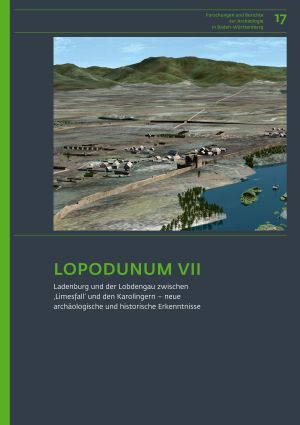Hildebrandt, Ludwig H.
LOPODVNVM VII: Ladenburg und der Lobdengau zwischen ‚Limesfall‘ und den Karolingern
Die Stadt Ladenburg kann auf ein reiches historisches Erbe zurückblicken: In der römischen Epoche war Lopodunum der Hauptort einer ausgedehnten Stadtgemeinde, der civitas Ulpia Sueborum Nicrensium, und ab der karolingischen Zeit ist Lobedtenburc als Zentrum des Lobdengaues belegt. Für den Zeitraum dazwischen fallen schriftliche Quellen weitgehend aus; umso wichtiger sind archäologische Befunde und Funde. Die bedeutendsten von diesen werden im vorliegenden Band vorgestellt und in den historischen Kontext eingebettet. So werden eine Gruppe von Postumus-Münzen aus Ladenburg präsentiert, neue Interpretationen des spätrömischen burgus und des mittelalterlichen ‚Bischofshofes‘ diskutiert sowie aktuelle Erkenntnisse zu einem karolingischen Gräberfeld im Stadtgebiet vorgelegt. Das Umland von Ladenburg ist durch Überblicke zu den reich ausgestatteten frühmittelalterlichen Gräberfeldern der Region und zu aktuellen Siedlungsgrabungen vertreten. Kritische Neubewertungen schriftlicher Quellen sowie historisch-archäologische Synthesen zu den verschiedenen möglichen Szenarien des ‚Limesfalles‘ und zu Vergleichsregionen wie der spätantiken Pfalz runden den Band ab.
Montanarchäologie in Europa: Berichte zum Internationalen Kolloquium »Frühe Erzgewinnung und Verhüttung in Europa« in Freiburg im Breisgau vom 4. bis 7. Oktober 1990
Ausgehend von den Vorträgen eines internationalen und interdisziplinär angelegten Symposiums (Oktober 1990) in Freiburg/Br. bietet der Band einen Überblick über die neuesten montanarchäologischen Untersuchungen in fast ganz Europa. Der Bogen der über 40 Beiträge spannt sich zeitlich vom urgeschichtlichen bis hin zum frühneuzeitlichen Bergbau. Berücksichtigt ist die Gewinnung von Gold und Silber, von Buntmetallen sowie von Eisen, wobei der Weg vom Erzabbau über die Verhüttung bis zur Weiterverarbeitung der Rohmetalle aufgezeigt wird und Schlagworte wie Arbeitsverhältnisse und Umwelteinflüsse die thematische Vielfalt des Bandes andeuten. Das mit einem umfangreichen Ortsregister und mit über 300 Abbildungen ausgestattete Buch zeigt anschaulich die Forschungsansätze, Methoden und bisherigen Ergebnisse der Montanarchäologie auf.








